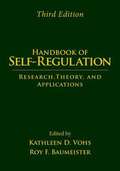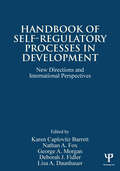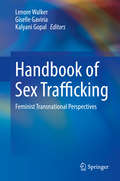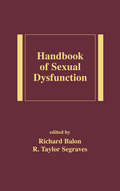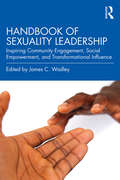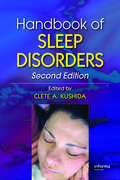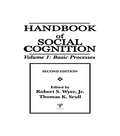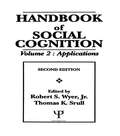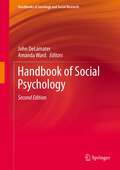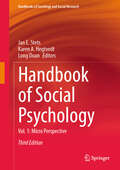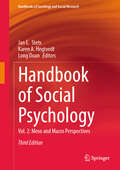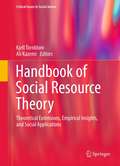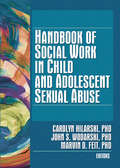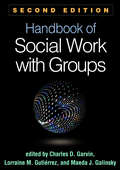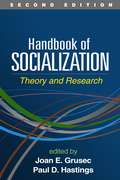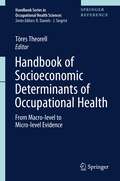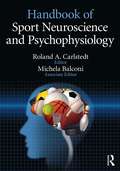- Table View
- List View
Handbook of Self-Regulation, Third Edition: Research, Theory, and Applications
by Roy F. Baumeister Kathleen D. VohsFrom leading authorities, this significantly revised and expanded handbook is a highly regarded reference in a rapidly growing field. It thoroughly examines the conscious and unconscious processes by which people manage their behavior and emotions, control impulses, and strive toward desired goals. Chapters explore such vital issues as why certain individuals have better self-control than others; how self-regulation shapes, and is shaped by, social relationships; underlying brain mechanisms and developmental pathways; and which interventions can improve people's self-control. The volume also addresses self-regulatory failures and their consequences, with chapters on attention-deficit/hyperactivity disorder, criminality, addictions, and money management challenges. As a special bonus, purchasers of the third edition can download a supplemental e-book featuring two notable, highly cited chapters from the second edition. New to This Edition *Incorporates the latest topic areas, theories, and empirical findings. *Updated throughout, with 21 new chapters and numerous new authors. *Cutting-edge topics: implicit self-regulation processes, the role of physical needs and processes (such as the importance of sleep), the benefits of dampening positivity, the frequency and consequences of emotional control in the workplace, and self-regulation training. *Expanded coverage of motivational factors, romantic relationships, and lapses of self-control.
Handbook of Self-Regulatory Processes in Development: New Directions and International Perspectives
by George A. Morgan Nathan A. Fox Karen Caplovitz Barrett Deborah J. Fidler Lisa A. DaunhauerThe development of self- and emotional regulatory processes helps children to regulate their behavior based on their cultural context and to develop positive social relationships. This handbook brings together heretofore disparate literatures on self- and emotional regulation, brain and physiological processes, mastery motivation, and atypical development to highlight how mastery motivation is related to self-regulation and to clarify the relation between these various processes. Authors from a variety of countries and backgrounds provide an integrated, up-to-date review of the research and the key theoretical models to demonstrate how these processes relate to cultural and individual differences in both typical and atypical development. The renowned editors, all experts in a particular domain of self-regulation, provide section opening chapters that review the literature, provide a perspective that explains the findings, and suggest directions for future research. Although the focus is on quantitative studies, some qualitative findings and research using brain imaging methodologies are included. Outstanding features include: Reviews the development of self and emotional regulation from infancy through adolescence. Contributors from various countries and backgrounds provide an integrative review of the literature to guide the direction of future research. Features contributions from those who have had a strong impact on self-regulation research. Reviews research on developmental disorders that have implications for self-regulation. There are four sections. Section one introduces the development of self- and emotional regulation. This section reviews how self-regulation adapts based on personal and culturally-based goals and how individual differences predispose some to behavior disorders. Socialization influences are examined including a look at when typical regulation processes go awry. Section 2 examines physiological and brain processes as they relate to the development of typical and atypical processes, along with neurocognitive development of performance monitoring and how these processes change over time, cortical activation differences, and behavioral and electrocortical measures of attentional bias. Section 3 reviews the development of self-regulation and mastery motivation including a review of the Dimensions of Mastery Questionnaire (DMQ), cross-national comparisons, and what the DMQ can tell us about self-regulation. The section concludes with a look at the development of self-regulation and mastery motivation in individuals with a developmental disability. Section 4 examines self-regulation in atypical development and evidence-based treatment approaches in children with ADHD, autism, and Down syndrome. This book is intended for researchers, graduate students, and practitioners in psychology, neuroscience, human development, and education interested in the development of self and emotional regulatory processes.
Handbook of Sex Trafficking: Feminist Transnational Perspectives
by Kalyani Gopal Lenore Walker Giselle GaviriaThis definitive reference assembles the current knowledge base on the scope and phenomena of sex trafficking as well as best practices for treatment of its survivors. A global feminist framework reflects a profound understanding of the entrenched social inequities and ongoing world events that fuel trafficking, including in its lesser-known forms. Empirically sound insights shed salient light on who buyers and traffickers are, why some survivors become victimizers, and the experiences of victim subpopulations (men, boys, refugees, sexual minorities), as well as emerging trends in prevention and protection, resilience and rehabilitation. These powerful dispatches also challenge readers to consider complex questions found at the intersections of gender, race, socioeconomic status, and politics. A sampling of topics in the Handbook: · An organizational systems view of sex trafficking. · Vulnerability factors when women and girls are trafficked. · Men, boys, and LGBTQ: invisible victims of human trafficking. · Organized crime, gangs, and trafficking. · Human trafficking prevention efforts for kids (NEST). · Treating victims of human trafficking: core therapeutic tasks. · From Trafficked to Safe House (C-SAFE). The Handbook of Sex Trafficking will interest a wide professional audience, particularly mental health workers, legal professionals, and researchers in these and related fields. Public health and law enforcement professionals will also find it an important resource.
Handbook of Sexual Assault and Sexual Assault Prevention
by William T. O’Donohue Paul A. ScheweThis timely handbook provides in-depth overviews of the myriad and multi-faceted issues surrounding sexual assault and its pervasiveness in today’s culture. Drawing for multiple viewpoints and experts, the book is divided into seven comprehensive sections, covering such topics as risk factors, varying theoretical frameworks, prevention and intervention, and special populations. Within these sections the authors provide historical background as well as the latest research, and offer treatment outcomes and potentials.Selected topics covered in this book include: Feminist theories of sexual assaultSocial and economic factors surrounding sexual violenceMental, physiological, physical, and functional health concerns of victims, including PTSDMajor categories of sexual offendersTreatment of sexual assault survivors in the LGBTQ+ communityProcedural processes related to sexual assault investigation and adjudication within the criminal justice system The Handbook of Sexual Assault and Sexual Assault Prevention is a vital book that will appeal to a broad spectrum of students, researchers, practitioners, and clinicians in the fields of psychology, psychiatry, community mental health, and sociology.
Handbook of Sexual Dysfunction
by Richard Balon R. Taylor SegravesOffering an authoritative collection of chapters from clinicians and researchers in the United States, Canada, and Europe, this reference comprehensively covers the latest understanding in the etiology, pathophysiology, diagnosis, and treatment of sexual dysfunction.
Handbook of Sexuality Leadership: Inspiring Community Engagement, Social Empowerment, and Transformational Influence
by James C. WadleyThis interdisciplinary book bridges the gap between sexuality and leadership studies and serves as a blueprint for professionals seeking to understand the rationale behind leadership styles, particularly those which facilitate conversations that educate or liberate individuals, couples, families, and communities. The Handbook of Sexuality Leadership brings together education, clinical, research, and advocacy experts from the field of sexology, who each speak of their unique leadership experiences – with diversity and inclusivity in mind – and serve as a medium of empowerment and transformational influence. This innovative compendium illuminates strategic planning, community engagement, and the necessity of working with underserved or marginalized communities using a combination of leadership styles. Chapters provide tools for risk taking, organizational improvement, collaborative leadership, and cultural intelligence, as well as strategies to emancipate underrepresented groups and lead systemic change. With questions for further thought included to provoke critical thinking and initiate transformative conversations, this book will be an essential read for anyone interested in becoming a sexuality consultant or serving in a leadership position.
Handbook of Sexuality-Related Measures
by William L. Yarber Terri D. Fisher Clive M. Davis Robin Milhausen John SakalukThis classic and invaluable reference handbook, written for sex researchers and their students, has now been completely revised in a new, fourth edition. It remains the only easy and efficient way for researchers to learn about, evaluate, and compare instruments that have previously been used in sex research.
Handbook of Sleep Disorders
by Clete A. KushidaNow in its second edition, Handbook of Sleep Disorders is the classic all-inclusive reference for sleep professionals around the world. Contributed by leading authorities, this new edition continues to provide a well-organized guide to the diagnosis and treatment of the six major categories of sleep disorders-insomnia, circadian
Handbook of Social Cognition: Volume 1: Basic Processes
by Robert S. Wyer Thomas K. SrullThis edition of the Handbook follows the first edition by 10 years. The earlier edition was a promissory note, presaging the directions in which the then-emerging field of social cognition was likely to move. The field was then in its infancy and the areas of research and theory that came to dominate the field during the next decade were only beginning to surface. The concepts and methods used had frequently been borrowed from cognitive psychology and had been applied to phenomena in a very limited number of areas. Nevertheless, social cognition promised to develop rapidly into an important area of psychological inquiry that would ultimately have an impact on not only several areas of psychology but other fields as well. The promises made by the earlier edition have generally been fulfilled. Since its publication, social cognition has become one of the most active areas of research in the entire field of psychology; its influence has extended to health and clinical psychology, and personality, as well as to political science, organizational behavior, and marketing and consumer behavior. The impact of social cognition theory and research within a very short period of time is incontrovertible. The present volumes provide a comprehensive and detailed review of the theoretical and empirical work that has been performed during these years, and of its implications for information processing in a wide variety of domains. The handbook is divided into two volumes. The first provides an overview of basic research and theory in social information processing, covering the automatic and controlled processing of information and its implications for how information is encoded and stored in memory, the mental representation of persons -- including oneself -- and events, the role of procedural knowledge in information processing, inference processes, and response processes. Special attention is given to the cognitive determinants and consequences of affect and emotion. The second book provides detailed discussions of the role of information processing in specific areas such as stereotyping; communication and persuasion; political judgment; close relationships; organizational, clinical and health psychology; and consumer behavior. The contributors are theorists and researchers who have themselves carried out important studies in the areas to which their chapters pertain. In combination, the contents of this two-volume set provide a sophisticated and in-depth treatment of both theory and research in this major area of psychological inquiry and the directions in which it is likely to proceed in the future.
Handbook of Social Cognition: Volume 2: Applications
by Robert S. Wyer Thomas K. SrullThis edition of the Handbook follows the first edition by 10 years. The earlier edition was a promissory note, presaging the directions in which the then-emerging field of social cognition was likely to move. The field was then in its infancy and the areas of research and theory that came to dominate the field during the next decade were only beginning to surface. The concepts and methods used had frequently been borrowed from cognitive psychology and had been applied to phenomena in a very limited number of areas. Nevertheless, social cognition promised to develop rapidly into an important area of psychological inquiry that would ultimately have an impact on not only several areas of psychology but other fields as well. The promises made by the earlier edition have generally been fulfilled. Since its publication, social cognition has become one of the most active areas of research in the entire field of psychology; its influence has extended to health and clinical psychology, and personality, as well as to political science, organizational behavior, and marketing and consumer behavior. The impact of social cognition theory and research within a very short period of time is incontrovertible. The present volumes provide a comprehensive and detailed review of the theoretical and empirical work that has been performed during these years, and of its implications for information processing in a wide variety of domains. The handbook is divided into two volumes. The first provides an overview of basic research and theory in social information processing, covering the automatic and controlled processing of information and its implications for how information is encoded and stored in memory, the mental representation of persons -- including oneself -- and events, the role of procedural knowledge in information processing, inference processes, and response processes. Special attention is given to the cognitive determinants and consequences of affect and emotion. The second book provides detailed discussions of the role of information processing in specific areas such as stereotyping; communication and persuasion; political judgment; close relationships; organizational, clinical and health psychology; and consumer behavior. The contributors are theorists and researchers who have themselves carried out important studies in the areas to which their chapters pertain. In combination, the contents of this two-volume set provide a sophisticated and in-depth treatment of both theory and research in this major area of psychological inquiry and the directions in which it is likely to proceed in the future.
Handbook of Social Influences in School Contexts: Social-Emotional, Motivation, and Cognitive Outcomes (Educational Psychology Handbook)
by Kathryn R. Wentzel Geetha B. RamaniThe Handbook of Social Influences in School Contexts draws from a growing body of research on how and why various aspects of social relationships and contexts contribute to children’s social and academic functioning within school settings. Comprised of the latest studies in developmental and educational psychology, this comprehensive volume is perfect for researchers and students of Educational Psychology. Beginning with the theoretical perspectives that guide research on social influences, this book presents foundational research before moving on to chapters on peer influence and teacher influence. Next, the book addresses ways in which the school context can influence school-related outcomes (including peer and teacher-student relationships) with specific attention to research in motivation and cognition. Within the chapters authors not only present current research but also explore best-practices, drawing in examples from the classroom. With chapters from leading experts in the field, The Handbook of Social Influences in School Contexts provides the first complete resource on this topic.
Handbook of Social Justice in Loss and Grief: Exploring Diversity, Equity, and Inclusion (Series in Death, Dying, and Bereavement)
by Darcy L. Harris Tashel C. BordereThe Handbook of Social Justice in Loss and Grief is a scholarly work of social criticism, richly grounded in personal experience, evocative case studies, and current multicultural and sociocultural theories and research. It is also consistently practical and reflective, challenging readers to think through responses to ethically complex scenarios in which social justice is undermined by radically uneven opportunity structures, hierarchies of voice and privilege, personal and professional power, and unconscious assumptions, at the very junctures when people are most vulnerable—at points of serious illness, confrontation with end-of-life decision making, and in the throes of grief and bereavement. Harris and Bordere give the reader an active and engaged take on the field, enticing readers to interrogate their own assumptions and practices while increasing, chapter after chapter, their cultural literacy regarding important groups and contexts. The Handbook of Social Justice in Loss and Grief deeply and uniquely addresses a hot topic in the helping professions and social sciences and does so with uncommon readability.
Handbook of Social Psychology
by John Delamater Amanda WardThis handbook provides a broad overview of the field of social psychology and up-to-date coverage of current social psychological topics. It reflects the recent and substantial development of the field, both with regard to theory and empirical research. It starts out by covering major theoretical perspectives, including the interactionist, identity, social exchange, social structure and the person perspectives. Next, it discusses development and socialization in childhood, adolescence and adulthood. In addition to updated discussions of topics that were included in the first edition, the part examining personal processes includes entirely new topics, such as social psychology and the body and individual agency and social motivation. Interpersonal processes are discussed from a contemporary perspective with a focus on stress and health. The final section examines the person in sociocultural context, and includes another topic new to the second edition, the social psychology of race and gender and intersectionality.
Handbook of Social Psychology: Vol. 1: Micro Perspective (Handbooks of Sociology and Social Research)
by Jan E. Stets Karen A. Hegtvedt Long DoanThis third edition of the highly successful handbook is presented for the first time in two volumes, covering the field of social psychology more comprehensively than earlier, including applying social psychology to different areas in sociology. It showcases the dynamics of social psychological phenomena across the micro level (Volume 1), and meso and macro levels of social reality (Volume 2). The reader will see how social psychology can be leveraged at the interactive level, within groups and larger units, and across many aspects of society, thus showing the expansiveness of social psychology in understanding social behavior, social organization, and social structures. The emphasis in Volume 1 rests on theoretical frameworks for processes occurring within individuals and among interacting individuals. The chapters span fundamental principles pertaining to the social construction of meaning, identity, emotions, language, and social cognition, and the structure and dynamics unfolding in interactions characterized by status, social exchange, network linkages, and justice. A shorter chapter, offering an empirical illustration, complements each theoretically oriented chapter. Together, the two volumes provide the reader with theoretical tools useful in understanding the basics of individual behavior, while highlighting how social psychological processes emerge in a variety of contexts. The connections among micro, meso, and macro levels, through the lens of social psychology, forge new pathways to understanding the various forms of inequality plaguing the social world.
Handbook of Social Psychology: Vol. 2: Meso and Macro Perspectives (Handbooks of Sociology and Social Research)
by Jan E. Stets Karen A. Hegtvedt Long DoanThis third edition of the highly successful handbook is presented for the first time in two volumes, covering the field of social psychology more comprehensively than earlier, including applying social psychology to different areas in sociology. It showcases the dynamics of social psychological phenomena across the micro level (Volume 1), and meso and macro levels of social reality (Volume 2). The reader will see how social psychology can be leveraged at the interactive level, within groups and larger units, and across many aspects of society, thus showing the expansiveness of social psychology in understanding social behavior, social organization, and social structures. Volume 2 highlights the relevance of social psychological principles and processes to social categories, groups, and organizations at the meso level, and to institutions and inequality that reflect social life at the macro level. Chapters pertaining to the meso level analyze individuals&’ memberships in social categories such as gender, race, class, age, and sexuality. Additionally, meso-level concerns spotlight the context of work and organizations. Chapters at the macro level consider social psychologically oriented work in such institutions as the family, education, and religion and examine other areas such as crime and deviance, the media, immigration, and health. Together, the two volumes provide the reader with theoretical tools useful in understanding the basics of individual behavior while highlighting how social psychological processes emerge in a variety of contexts. The connections among micro, meso, and macro levels, through the lens of social psychology, forge new pathways to understanding the various forms of inequality plaguing the social world.
Handbook of Social Resource Theory
by Kjell Törnblom Ali KazemiA "social resource" refers to anything that is transacted between two people. It encompasses both the tangible (such as money and material goods) and the intangible (such as love, respect, information, or services) that are provided or withheld in people's daily lives. The exchange and availability of social resources have a wide range of impacts on everything from health, to quality of life, to social status, to motivation. Understanding Social Resource Theory (SRT) is a key to both Social Psychology (both sociological and psychological), and Public Policy. The framework for the study of SRT is relatively new, beginning with an article by Uriel G. Foa in 1971. Since then, this framework has developed to include new types of social resources and new applications. The Editors of this volume have worked directly with Dr. Foa before his passing, and this volume represents a continuation and development of SRT framework to new applications, including: -Quality of Life -Work Satisfaction -Interpersonal Relationships -Cognitive Development -Consumer Behavior -Cross-Cultural Behavior Contributions to Handbook of Social Resource Theory also integrate SRT with other prevailing Sociological frameworks, including: distributive and procedural justice, social comparison theory, and development of social relationships. SRT has already established a link between social psychology and economics, and this link is explored even further. With clear applications to many fields of study, including Sociology, Social Psychology, Public Policy, and Quality of Life research, this interdisciplinary volume is a clear, systematic, and comprehensive approach to understanding Social Resource Theory, its range of applications, and the future directions of research.
Handbook of Social Work in Child and Adolescent Sexual Abuse
by John S. Wodarski Marvin D. Feit Carolyn HilarskiThe enlightening collection of new approaches to understanding sexual abuseWhen sexual abuse occurs, helping those directly affected can be a difficult and convoluted task. The Handbook of Social Work in Child & Adolescent Sexual Abuse is a comprehensive guide that provides the latest information on assessment, management, prevention, and policy. Through insightful and accessible discussions, this collection of essays encompasses the full spectrum of child and adolescent sexual abuse to shed needed light on an affecting issue. This innovative text is the up-to-date source for unique and compassionate ways of supporting and treating survivors.The increased attention given to child sexual abuse in recent years has revealed how little we know about this tragedy. The Handbook of Social Work in Child & Adolescent Sexual Abuse is the practical compendium that covers the already existing information regarding violence against children and delves into practical methods for treating those immediately affected by it. From its historical place in society to contemporary issues of prevention that have only recently come to light, contributors examine essential details in-depth and provide concise, empirical directions for short- and long-term support. Also included is the important and newly-available assessment and treatment information focusing on ethnicity, gender, and comorbid influences as they relate to family member treatment.Among the topics discussed in the Handbook of Social Work in Child & Adolescent Sexual Abuse are: historical views of and responses to sexual abuse risk and protective factors life stage consequences theories of family dysfunction comorbidity and attachment intrafamilial abuse the non-family offender current empirical assessment methods approaches to treatment in children approaches to treatment in adolescents neurological effects of abuse treatment for the non-offending caregiver the role of the internet and other media policy and practice implications the prevalence and consequences of abuse new methods of abuse prevention and child protection the etiology of sexual offending in an attachment framework and much more!The Handbook of Social Work in Child & Adolescent Sexual Abuse is an essential resource for educators, medical practitioners, psychologists, psychiatrists, social workers, counselors, family therapists, and students, researchers, and academics in the field of social work.
Handbook of Social Work with Groups, Second Edition
by Charles D. Garvin Maeda J. Galinsky Lorraine M. GutiérrezThis definitive text, now revised and expanded, has introduced thousands of students and practitioners to the theory and practice of social work with groups. Leading authorities outline major models of group work and address critical issues in planning, implementing, and evaluating interventions. The Handbook describes applications in all the major practice settings--mental health, prevention, child welfare, substance abuse, health care, aging, corrections, and more--as well as organizational and community settings. A strong focus on empowerment, social justice, and diversity is woven throughout. The empirical foundations of group work are reviewed, and innovative research methods discussed. New to This Edition: *Incorporates over a decade of advances in the field *Heightened focus on practitioner-researcher collaboration. *Two chapters on substance abuse prevention with youth. *Chapters on social justice work, evidence-based practice, offender reentry, intimate partner violence, intergroup dialogue, working with immigrants and refugees, qualitative methods, and intervention research. *Major updates on existing topics, such as cognitive-behavioral group work, psychoeducational groups, health care settings, and technology-mediated groups. *Integrative epilogue that synthesizes key themes.
Handbook of Social and Emotional Learning
by Daniel Goleman James P. Comer Thomas P. Gullotta Linda Darling-Hammond Celene E. Domitrovich Roger P. Weissberg Timothy P. Shriver Jennifer Buffett Joseph A. DurlakThe burgeoning multidisciplinary field of social and emotional learning (SEL) now has a comprehensive and definitive handbook covering all aspects of research, practice, and policy. The prominent editors and contributors describe state-of-the-art intervention and prevention programs designed to build students' skills for managing emotions, showing concern for others, making responsible decisions, and forming positive relationships. Conceptual and scientific underpinnings of SEL are explored and its relationship to children's and adolescents' academic success and mental health examined. Issues in implementing and assessing SEL programs in diverse educational settings are analyzed in depth, including the roles of school- and district-level leadership, teacher training, and school-family partnerships.
Handbook of Social and Emotional Learning
by The Weissberg ScholarsThe definitive work on social and emotional learning (SEL) research and practice is now in an extensively revised second edition, featuring all-new and thoroughly updated chapters. The world&’s leading SEL scholars describe state-of-the-art interventions that build students' competencies for managing emotions, showing empathy for others, forming supportive relationships, and making responsible decisions. The scientific underpinnings of SEL are explored and its impact on academic achievement and behavior is examined. The Handbook discusses ways to assess SEL and design effective, developmentally and culturally informed programs for students in preschool through secondary school settings and beyond. New to This Edition *Reflects a decade of significant advances in research, policy, and implementation. *New and expanded topics--equity, culturally responsive practice, multi-tiered systems of support, adult SEL, technology tools and applications, mental health, scaling up successful interventions, and more. *Six chapters on international SEL efforts, discussing both developed and developing countries. *Every chapter concludes with Key Takeaway Points.
Handbook of Socialization, Second Edition
by Joan E. Grusec Paul D. HastingsThis highly regarded handbook remains the leading reference and advanced text on socialization. Bringing together foremost authorities, the volume reviews the breadth of current knowledge on socialization processes across the lifespan. Contributors present cutting-edge theories and findings pertaining to family, peer, school, community, media, and other influences on individual development. Genetics and biology, cultural psychology, and affective science are given particular attention. Three themes guide the book: the interdependence of biology and experience, the bidirectionality of socialization processes, and the many contributing factors that interact to produce multiple socialization processes and pathways. New to This Edition *Revised structure reflects the diversity of socializing relationships in multiple contexts across the lifespan. *Chapters on adolescence, socialization in the workplace, moral development, culture, and neuroscience. *Many new authors and extensively revised chapters.
Handbook of Socioeconomic Determinants of Occupational Health: From Macro-level to Micro-level Evidence (Handbook Series in Occupational Health Sciences)
by Töres TheorellThis anthology provides readers of scientific literature on socioeconomic factors and working conditions with the newest knowledge in this field. Since our world is subjected to constant change in accelerating speed, scientific reviews and updates are needed. Fortunately, research methodology in epidemiology, physiology, psychology and sociology is also developing rapidly and therefore the scientific community can provide politicians and policy makers with increasingly sophisticated and exact descriptions of societal factors in relation to work. The anthology starts in the macro level sphere – with international perspectives and reviews related to working conditions in relation to political change (the fall of the Soviet Union) gender, age, precarious employment, national economy and retirement. Two chapters relate to national policies and activities in international organizations. The second part of the book relates to the meso level sphere – with reviews on social patterns in distributions of psychosocial and physical risks at work in general as well as reviews on noise, shift work, under/overemployment, occupational physical activity, job intensity (which may be a particularly important problem in low income countries), digitization in modern work, climate change, childhood determinants of occupational health in adult years and theoretical models currently used in occupational epidemiology - demand/control, effort/reward, organizational justice, psychosocial safety climate, conflicts, bullying/harassment. This part of the book ends with two chapters on interventions (one chapter on the use of cultural interventions and one on interventions and their evaluation in general) and two chapters on financial aspects of poor/good work environments and evaluations of interventions. In the third part of the book the micro level is addressed. Here mechanisms translating working conditions into physiology are discussed. This starts in general theory relating basic theories regarding energy storage and release to psychosocial theory (extension of demand control theory). It also includes regeneration physiology, autonomic nervous system function, immunology and adverse behaviour.Sections in the Handbook: Macro-level determinants of occupational health: Akizumi Tsutsumi, Meso-level determinants of occupational health: Morten Wahrendorf and Jian Li, Micro-level determinants of occupational health: Bradley J. Wright
Handbook of Solution-Focused Brief Therapy: Clinical Applications
by Frank N. Thomas Thorana S. NelsonAn invaluable guide to the history, descriptions of practice strategies, and applications of SFBT The Handbook of Solution-Focused Brief Therapy is a unique, comprehensive guide that assists clinicians, regardless of experience level, in learning and applying the concepts of Solution-Focused Brief Therapy (SFBT) to particular situations with clients. Noted experts discuss the therapy practices and various uses for the approach in detail, which focuses on encouraging clients to look at exceptions, times when the problem could have occurred and did not, and goals and future possibilities. A history of the practice model and its interventions is discussed, along with limitations, descriptions of practice strategies, applications to specific client populations, and clinical problems and concerns. This useful resource also includes an illustrative case study that uses the SFBT model. The Handbook of Solution-Focused Brief Therapy first lays a foundation of knowledge, providing chapters on the crucial assumptions and practices, history, and epistemology behind the approach. Further chapters use that basis to explain the application of the approach with several clinical issues and various populations, including couples, depression, domestic violence, schools, children, pastoral work, therapist burnout, and a few "outside therapy room" applications. Other chapters focus on the important issues in therapist training and supervision. Extensive references are provided at the end of each chapter. Topics discussed in the Handbook of Solution-Focused Brief Therapy include: assumptions within the SFBT tradition history of the SFBT approach epistemology SFBT with couples depression domestic violence offenders public schools children and young people SFBT in faith-based communities assessing and relieving burnout in mental health practice SFBT beyond the therapy room supervision of training possible limitations, misunderstandings, and misuses of SFBT a tribute to the late Steven de Shazer, co-founder of the SFBT approach The Handbook of Solution-Focused Brief Therapy is an invaluable reference for all types of therapists, including psychologists, counselors, social workers, and family therapists at any level of experience, including students, trainees, and experienced therapists.
Handbook of Speech-Language Therapy in Sub-Saharan Africa: Integrating Research and Practice
by Ulrike M. Lüdtke Edward Kija Mathew Kinyua KariaThis book synthesizes research on language development and communication disability in Sub-Saharan Africa and highlights best practices for providing speech and language therapy services to individuals with language, communication, and hearing disorders across the lifespan. The book brings together a wide range of international contributions from various disciplines, such as speech-language pathology, audiology, developmental psychology, language education, social work, neurology, neuropsychology, pediatrics, linguistics, pedagogy, and phonetics to provide perspectives on problems, challenges, ideas, concepts, and models to serve the people in Sub-Saharan Africa. Key areas of coverage include:Challenges for speech-language therapists in the health sector.Community awareness and the sustainable delivery of services.Culture-specific support of communication and language development in early childhood.Malnutrition, dysphagia, feeding difficulties, pediatric HIV, and related issues.Communication disability treatments, including assessment and intervention, augmentative and alternative communication (AAC), and issues specific to bilingualism and biliteracy.Inclusive education of children with communication disorders with case studies from Rwanda, Tanzania, Kenya, and South Africa. The Handbook of Speech-Language Therapy in Sub-Saharan Africa is an essential reference for researchers, professors, and graduate students as well as clinicians, therapists, and other professionals in developmental psychology, speech-language pathology and therapy, social work, neuropsychology, pediatrics, special education, community based rehabilitation, and all related disciplines.
Handbook of Sport Neuroscience and Psychophysiology
by Roland CarlstedtOut of the broad arena of sport science and sport psychology, Roland A. Carlstedt presents a comprehensive collection on the neuroscience and associated psychophysiology that underlies and drives sport performance. Featuring sections ranging from the basics and foundations (anatomy and physiology) to the applied (assessment during competition, training, and mental training), Handbook of Sport Neuroscience and Psychophysiology is the first volume to provide students, researchers, practitioners, and coaches the latest knowledge on the brain, mind-body processes, and psychophysiological responding in the context of sport performance.
